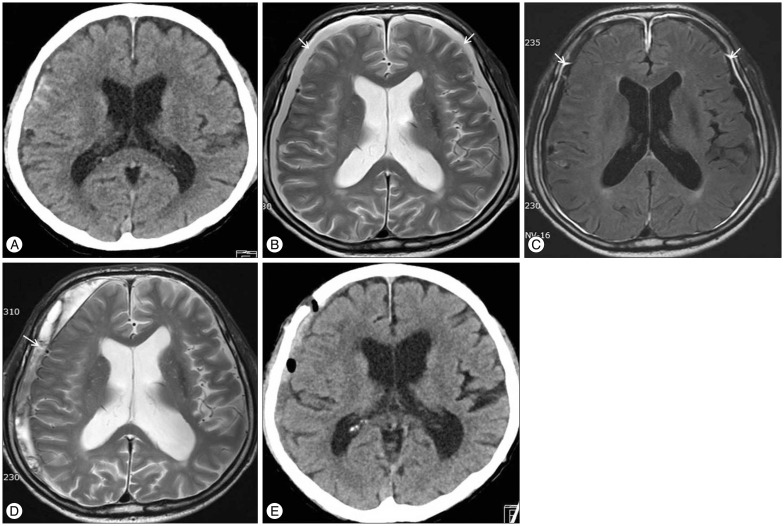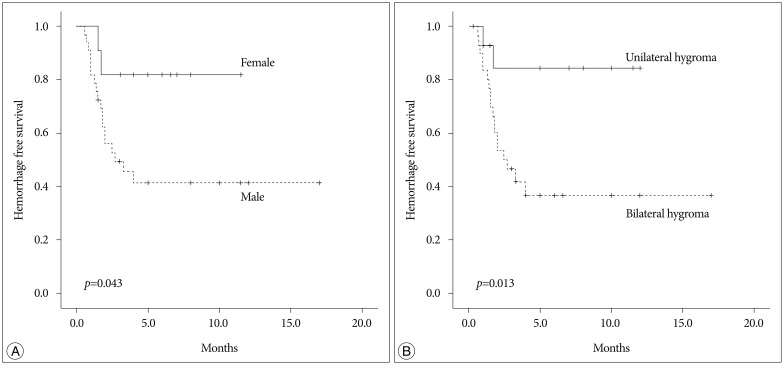J Korean Neurosurg Soc.
2016 Nov;59(6):622-627. 10.3340/jkns.2016.59.6.622.
Analysis of Risk Factor for the Development of Chronic Subdural Hematoma in Patients with Traumatic Subdural Hygroma
- Affiliations
-
- 1Department of Neurosurgery, Hallym University Sacred Heart Hospital, Anyang, Korea. nscib71@hanmail.net
- KMID: 2417346
- DOI: http://doi.org/10.3340/jkns.2016.59.6.622
Abstract
OBJECTIVE
Although a high incidence of chronic subdural hematoma (CSDH) following traumatic subdural hygroma (SDG) has been reported, no study has evaluated risk factors for the development of CSDH. Therefore, we analyzed the risk factors contributing to formation of CSDH in patients with traumatic SDG.
METHODS
We retrospectively reviewed patients admitted to Hallym University Hospital with traumatic head injury from January 2004 through December 2013. A total of 45 patients with these injuries in which traumatic SDG developed during the follow-up period were analyzed. All patients were divided into two groups based on the development of CSDH, and the associations between the development of CSDH and independent variables were investigated.
RESULTS
Thirty-one patients suffered from bilateral SDG, whereas 14 had unilateral SDG. Follow-up computed tomography scans revealed regression of SDG in 25 of 45 patients (55.6%), but the remaining 20 patients (44.4%) suffered from transition to CSDH. Eight patients developed bilateral CSDH, and 12 patients developed unilateral CSDH. Hemorrhage-free survival rates were significantly lower in the male and bilateral SDG group (log-rank test; p=0.043 and p=0.013, respectively). Binary logistic regression analysis revealed male (OR, 7.68; 95% CI 1.18-49.78; p=0.033) and bilateral SDG (OR, 8.04; 95% CI 1.41-45.7; p=0.019) were significant risk factors for development of CSDH.
CONCLUSION
The potential to evolve into CSDH should be considered in patients with traumatic SDG, particularly male patients with bilateral SDG.
MeSH Terms
Figure
Reference
-
1. Apfelbaum RI, Guthkelch AN, Shulman K. Experimental production of subdural hematomas. J Neurosurg. 1974; 40:336–346. PMID: 4813715.
Article2. Baechli H, Nordmann A, Bucher HC, Gratzl O. Demographics and prevalent risk factors of chronic subdural haematoma : results of a large single-center cohort study. Neurosurg Rev. 2004; 27:263–266. PMID: 15148652.3. Caldarelli M, Di Rocco C, Romani R. Surgical treatment of chronic subdural hygromas in infants and children. Acta Neurochir (Wien). 2002; 144:581–588. discussion 588. PMID: 12111491.
Article4. Dandy WE. Treatment of an unusual subdural hydroma (external hydrocephalus). Arch Surg. 1946; 52:421–428. PMID: 20983109.
Article5. French BN, Cobb CA 3rd, Corkill G, Youmans JR. Delayed evolution of posttraumatic subdural hygroma. Surg Neurol. 1978; 9:145–148. PMID: 635758.6. Friede RL, Schachenmayr W. The origin ofsubdural neomembranes. II. Fine structural of neomembranes. Am J Pathol. 1978; 92:69–84. PMID: 686149.7. Fujioka S, Matsukado Y, Kaku M, Sakurama N, Nonaka N, Miura G. [CT analysis of 100 cases with chronic subdural hematoma with respect to clinical manifestation and the enlarging process of the hematoma (author's transl)]. Neurol Med Chir (Tokyo). 1981; 21:1153–1160. PMID: 6174887.
Article8. Hasegawa M, Yamashima T, Yamashita J, Suzuki M, Shimada S. Traumatic subdural hygroma : pathology and meningeal enhancement on magnetic resonance imaging. Neurosurgery. 1992; 31:580–585. PMID: 1407439.9. Kaufman HH, Childs TL, Wagner KA, Bernstein DP, Karon M, Khalid M, et al. Post-traumatic subdural hygromas : observations concerning a surgical enigma. Acta Neurochir (Wien). 1984; 72:197–209. PMID: 6475575.
Article10. Kawaguchi T, Fujita S, Hosoda K, Shibata Y, Komatsu H, Tamaki N. Treatment of subdural effusion with hydrocephalus after ruptured intracranial aneurysm clipping. Neurosurgery. 1998; 43:1033–1039. PMID: 9802846.
Article11. Kawano N, Endo M, Saito M, Yada K. [Origin of the capsule of a chronic subdural hematoma--an electron microscopy study]. No Shinkei Geka. 1988; 16:747–752. PMID: 3412561.12. Lee KS, Bae WK, Bae HG, Yun IG. The fate of traumatic subdural hygroma in serial computed tomographic scans. J Korean Med Sci. 2000; 15:560–568. PMID: 11068995.
Article13. Lee KS, Bae WK, Park YT, Yun IG. The pathogenesis and fate of traumatic subdural hygroma. Br J Neurosurg. 1994; 8:551–558. PMID: 7857535.
Article14. Lee KS, Bae WK, Yoon SM, Doh JW, Bae HG, Yun IG. Location of the traumatic subdural hygroma : role of gravity and cranial morphology. Brain Inj. 2000; 14:355–361. PMID: 10815843.15. Nakaguchi H, Tanishima T, Yoshimasu N. Factors in the natural history of chronic subdural hematomas that influence their postoperative recurrence. J Neurosurg. 2001; 95:256–262. PMID: 11780895.
Article16. Ohno K, Suzuki R, Masaoka H, Matsushima Y, Inaba Y, Monma S. Role of traumatic subdural fluid collection in developing process of chronic subdural hematoma. Bull Tokyo Med Dent Univ. 1986; 33:99–106. PMID: 3471365.17. Ohno K, Suzuki R, Masaoka H, Matsushima Y, Inaba Y, Monma S. Chronic subdural haematoma preceded by persistent traumatic subdural fluid collection. J Neurol Neurosurg Psychiatry. 1987; 50:1694–1697. PMID: 3437306.
Article18. Park CK, Choi KH, Kim MC, Kang JK, Choi CR. Spontaneous evolution of posttraumatic subdural hygroma into chronic subdural haematoma. Acta Neurochir (Wien). 1994; 127:41–47. PMID: 7942180.
Article19. Park SH, Lee SH, Park J, Hwang JH, Hwang SK, Hamm IS. Chronic subdural hematoma preceded by traumatic subdural hygroma. J Clin Neurosci. 2008; 15:868–872. PMID: 18502131.
Article20. Sambasivan M. An overview of chronic subdural hematoma : experience with 2300 cases. Surg Neurol. 1997; 47:418–422. PMID: 9131021.21. Schachenmayr W, Friede RL. The origin of subdural neomembranes. I. Fine structure of the dura-arachnoid interface in man. Am J Pathol. 1978; 92:53–68. PMID: 686148.22. Sohn IT, Lee KS, Doh JW, Bae HG, Yun IG, Byun BJ. A prospective study on the incidence, patterns and premorbid conditions of traumatic subdural hygroma. J Korean Neurosurg Soc. 1997; 26:87–93.23. Sousa EB, Brandão LF, Tavares CB, Borges IB, Neto NG, Kessler IM. Epidemiological characteristics of 778 patients who underwent surgical drainage of chronic subdural hematomas in Brasília, Brazil. BMC Surg. 2013; 13:5. PMID: 23452673.
Article24. Spallone A, Giuffrè R, Gagliardi FM, Vagnozzi R. Chronic subdural hematoma in extremely aged patients. Eur Neurol. 1989; 29:18–22. PMID: 2707288.
Article25. Stone JL, Lang RG, Sugar O, Moody RA. Traumatic subdural hygroma. Neurosurgery. 1981; 8:542–550. PMID: 7266792.
Article26. Watanabe S, Shimada H, Ishii S. Production of clinical form of chronic subdural hematoma in experimental animals. J Neurosurg. 1972; 37:552–561. PMID: 4627704.
Article27. Yamada H, Nihei H, Watanabe T, Shibui S, Murata S. [Chronic subdural hematoma occurring consequently to the posttraumatic subdural hygroma--on the pathogenesis of the chronic subdural hematoma (author's transl)]. No To Shinkei. 1979; 31:115–121. PMID: 426938.
- Full Text Links
- Actions
-
Cited
- CITED
-
- Close
- Share
- Similar articles
-
- Chronic Subdural Hematoma Superimposed on Posttraumatic Subdural Hygroma: A Report of Three Cases
- Clinical Analysis of Traumatic Subdural Hygroma
- Clinical Analysis of Chronic Subdural Hematoma Originated from Traumatic Subdural Hygroma
- Clinical Evaluation of the Traumatic Subdural Hygroma
- Chronic Subdural Hematoma Secondary to Traumatic Subdural Hygroma




